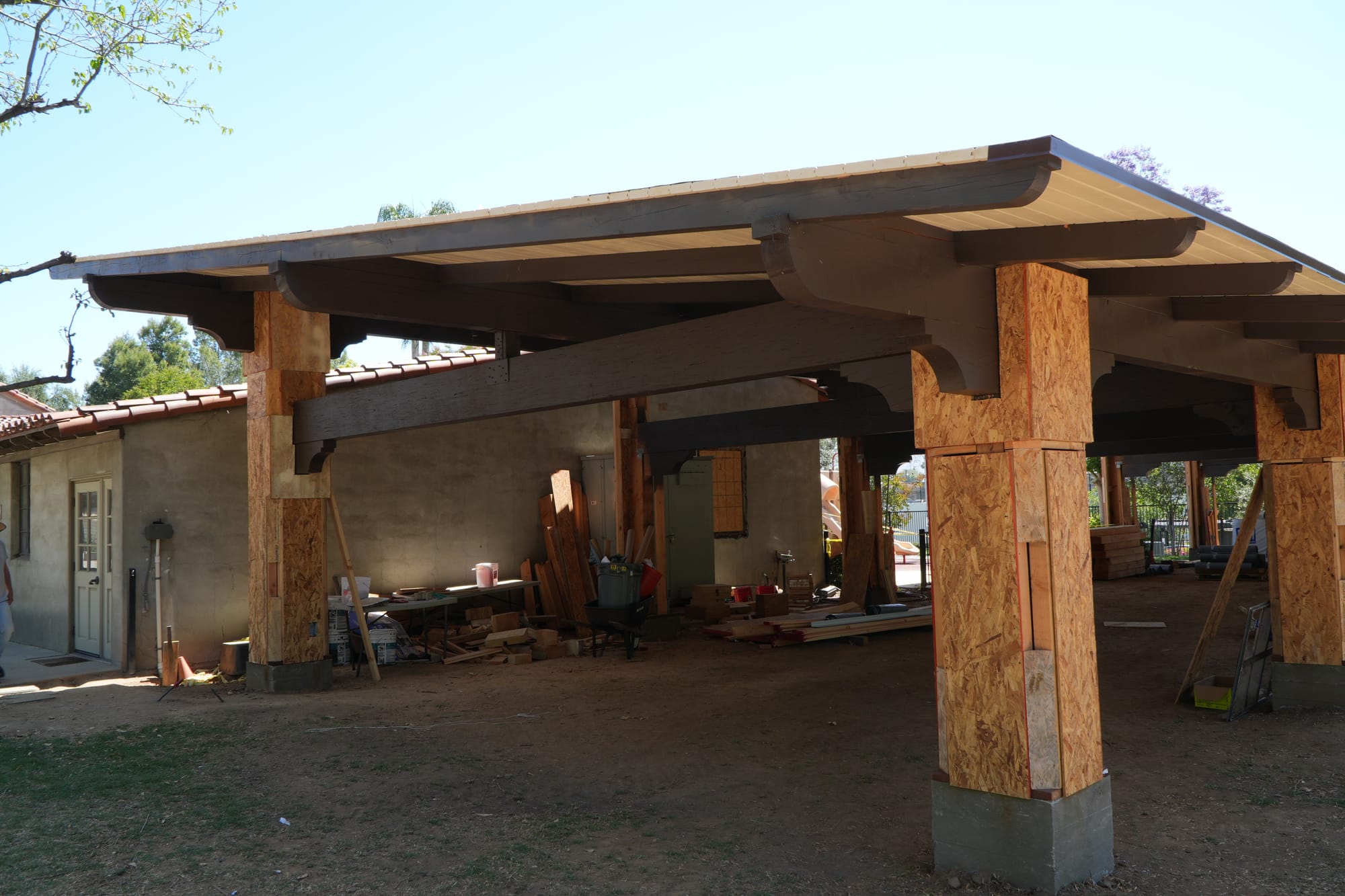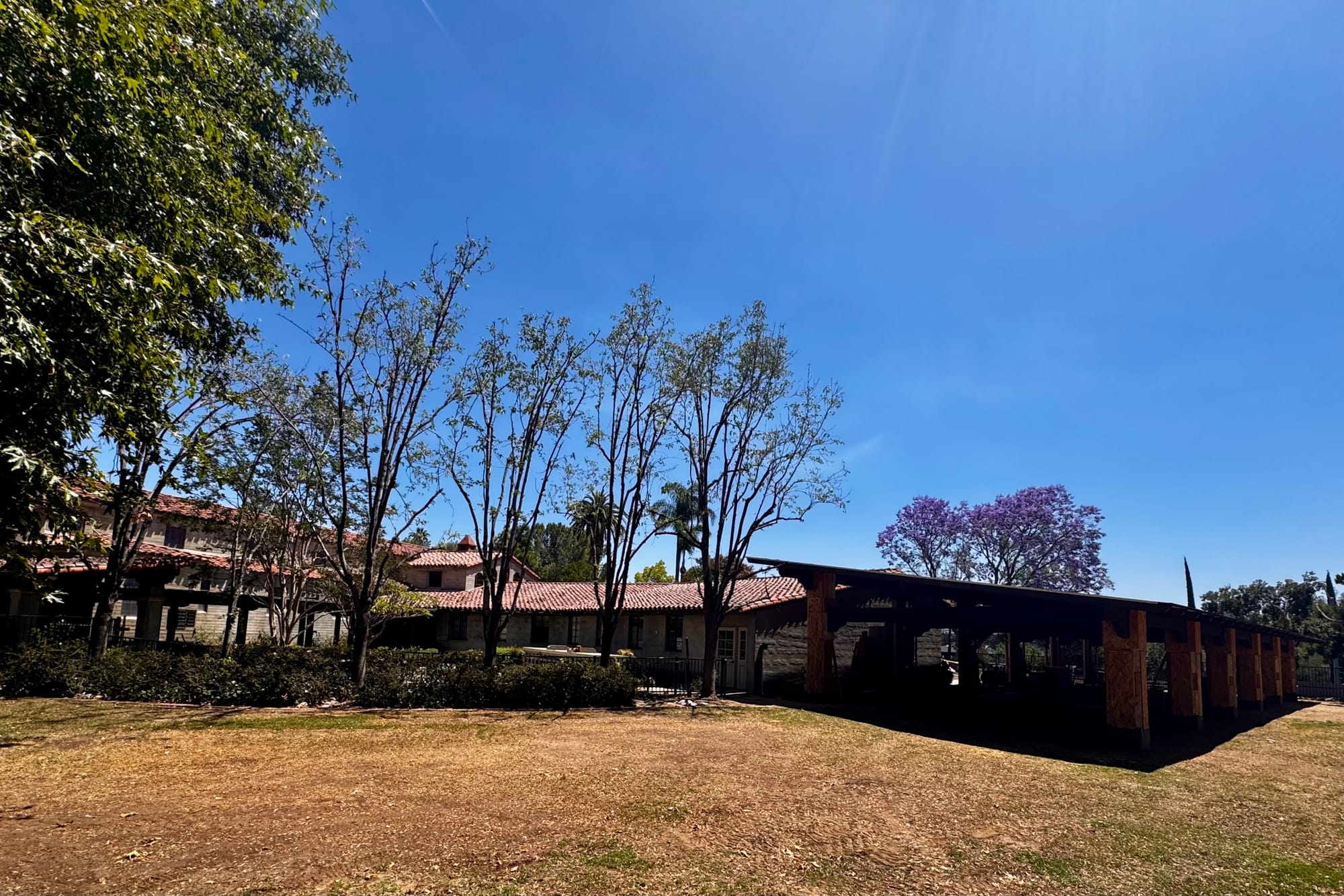Share Your Favorite Holiday Light Displays: Riverside Family Shines on National TV
The Kopatz family brought holiday cheer to national television this week, competing on ABC's "The Great Christmas Light Fight" on Dec. 4.
How All Saints Episcopal Church designed a solution that preserves architectural heritage while advancing sustainability and creating a new community space.

All Saints Episcopal Church in Riverside is nearing completion of a $257,000 solar project that features a 60-by-30-foot steel pergola topped with solar panels. Set to be fully operational by mid-June, the 61-kilowatt system is expected to eliminate the church's $1,500 monthly electric bill while generating surplus clean energy for the community.
The historic church, founded as a mission in 1884, opted for a standalone structure instead of traditional rooftop installation to preserve the Spanish Mission-style architecture of its landmark building. The solar pergola will double as a shaded gathering space for both the congregation and community, featuring ceiling fans, lighting, and electrical outlets.


(Ken Crawford)
"We're sort of the poster child for long-established churches in Riverside to be going to 100% solar, and especially because of our location, you know, we're here with RCC students and at this intersection and it's pretty exciting," said Francisca Johnson, a longtime member of the congregation.
The project features an extensive solar array covering almost the entire roof structure. "The roof is 3,200 square feet, and almost every inch of it is going to be covered by solar panels," explained Steve Slaten, who has led the project from its inception. "We got a 61-kilowatt system going out, which is allowable by RPU. That is more than what we use annually, which they allow. So any energy that we generate and don't use goes into the grid and contributes to clean energy for other people and the community. That's a feature that we really like from the church's standpoint—being able to share with the community."
The project is part of a comprehensive sustainability initiative that includes the electrification of the church's kitchen, water-wise irrigation systems, and conversion to LED lighting throughout the campus. The successful capital campaign allowed them to purchase nearly all materials early in the process, protecting them from inflation and supply chain disruptions.
"Our capital campaign was successful. When we started this, we were well funded," Slaten said. "That allowed us to purchase the solar panels—probably 95% of all the material to be used on the job we were able to purchase right then and there. So we locked it in. We were worried about tariffs and inflation, tariff-fueled inflation, so we were able to cut a couple of big checks right away. That worked out well for us."
One of the biggest challenges came when the team discovered that the church had been designated a city landmark some 20 years ago, requiring approval from the Heritage Review Committee. Traditional rooftop solar wasn't an option due to the historic red tile roof of the Spanish-style church. The team envisioned a standalone structure instead, but city requirements initially mandated that the new structure be attached to the existing building.
Johnson explained how they approached the design process: "We had solar companies bidding us what they think our solar structure should look like, and basically, they were proposing things that you see in the parking lot of UCR. Needless to say, we didn't want that because we didn't want to cover our parking lot because it would change the aesthetics of the building when you drive in. It's a beautiful campus built in 1948. So we went back to the drawing board and said, let's build something that can hold all the solar panels we need for the energy we use, but that also will be here forever and will also become a pavilion for the congregation and the community to use for gatherings, worship services, celebrations, et cetera."
Working with Chastain Building Group, they developed a creative solution—what the city calls a "seismic separation." This breezeway connects the new structure to the existing building while maintaining the structural integrity of both. Two glass French doors will provide access from the interior hallway of the Smith South Wing.
The back third of the structure will feature a walking labyrinth that had to be removed during construction. Decomposed granite will be laid underneath, with grass growing in sections. The pillars will receive stucco in the same color and general shape as the existing buildings, maintaining aesthetic harmony with the historic campus. The space will include power outlets for electronics, with the ability to shut off power to certain sections as needed.
For All Saints, the solar project represents not just a commitment to environmental stewardship but also financial wisdom. The money currently spent on electricity can instead be redirected toward community programming. This financial aspect has been key in explaining the project's value to congregation members who initially questioned the investment.
The reframing of environmentalism as sustainability has been crucial in communicating the project's value. Rather than presenting the initiative as purely environmental activism, leaders have emphasized its economic benefits and long-term sustainability, freeing up financial resources while being responsible stewards of both the environment and the church's finances.
The church is already looking ahead to future sustainability initiatives. Plans include creating a community garden on church property behind a building that currently houses young men who have aged out of foster care. They're also considering installing EV charging stations, with plans to run conduit during the current construction to prepare for future installation.
Eventually, they hope to add battery storage that would allow them to function as a community resilience hub during emergencies. The congregation had been working with Dr. Lucy Jones, the well-known seismologist, on a grant proposal to develop such a hub. Riverside was chosen because it met numerous criteria for environmental and disaster risks, including fire, air pollution, and earthquake hazards. Though the specific funding didn't materialize, they remain committed to that vision.
At last year's Diocesan Climate Summit, the project leaders shared insights about the permitting and installation process, helping shape a replicable model that other congregations have already begun asking to follow.
The Rev. Canon Kelli Grace Kurtz, rector of All Saints, sees the project as part of a larger vision. "We have this list of things we think God is calling us to do... just looking at all the different ways we can care for creation," she told The Episcopal News in January 2024. "This is a legacy project. We want the grandchildren of the children in our Sunday school to come back on campus as adults and say, 'My grandparents were a part of making sure this church stayed, and that Riverside was a little cleaner.'"
What makes this project particularly noteworthy is how it harmonizes sustainability with cultural heritage preservation. "We often think of sustainability as adversarial to cultural heritage issues like making new construction that respects the history of buildings and neighborhoods," said Kurtz. "This project brings those worlds together."
The church's project also benefits from the federal Inflation Reduction Act, which now allows nonprofit organizations to receive direct payments for renewable energy investments. This provision, which wasn't previously available to churches, has made solar installations more financially feasible for faith communities across the country.
The church's location on one of the most well-traveled corners in the city makes it ideal for community outreach. All Saints houses a nonprofit providing childcare on a sliding scale and leases space to Alcoholics Anonymous. The childcare center occupies the entire bottom level of the North Wing, accessed from the lower parking lot.
The community focus of All Saints extends beyond providing space to community organizations. The solar project represents the central aspect of their broader "care of creation" program, which encompasses all their sustainability initiatives.
This effort aligns with the Episcopal Church's larger commitment to environmental stewardship. In 2022, the Episcopal Church's General Convention committed to making the entire denomination carbon neutral by 2030, a goal that applies to all 6,300 Episcopal congregations nationwide. The church has created a Covenant for the Care of Creation, which calls on parishes to practice "loving formation, liberating advocacy, and life-giving conservation" in their approach to environmental issues.
All Saints' project stands as a model for how historic institutions can embrace renewable energy while honoring their architectural heritage—and how environmental stewardship can align with fiscal responsibility and community service. As it nears completion, the project offers both practical lessons in implementation and inspiration for other faith communities looking to make similar transitions.
More Information: To learn more or support the solar project, visit allsaintsriverside.org.
Let us email you Riverside's news and events every morning. For free!